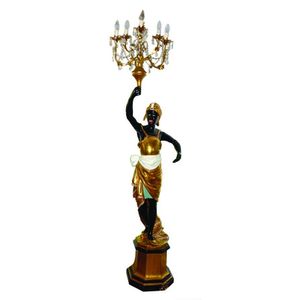Bronze Temple Guardian Censer with Gilt Details
You must be a subscriber, and be logged in to view price and dealer details.
Subscribe Now to view actual auction price for this item
When you subscribe, you have the option of setting the currency in which to display prices to $Au, $US, $NZ or Stg.
- Bronze - An alloy of copper and tin, traditionally in the proportions of about 9 parts of copper to 1 part of tin.
The discovery of bronze in Western Asia in the 4th century enabled people to create metal objects which were superior to those previoulsy possible because of its strength and hardness, and it has been used throughout the world for weapons, coins, tools, statuary and other decorative items.
It is very fluid in a molten state, and its hardness, strength when set, and non-corrosive properties makes it most suitable for casting sculpture. - Finial - An architectural decoration, found on the upper parts of of an object. On furniture they are usually found on pediments, canopies and shelf supports. On smaller ceramic or silver items, such as spoons, they may decorate the top of the item itself, or the lid or cover where they provide a useful handle for removal.
Finials have a variety of shapes and forms. They may be urn-shaped, baluster shaped round or spiral, but usually taper into an upper point. Many real life shapes may also be used as finials, such as pineapples, berries, pinecones, buds, lotus and acorns. Sometimes animals such as a lion are depicted, or fish and dolphins. - Rosewood - A dense timber that varies in shade to very light brown to almost black. When rosewood is cut and sanded the colour of the timber will turn black, and after polishing and exposure to daylight, the surface will gradually lighten over time to light brown with black streaks.
The name comes from the odour emanating from the timber when it is planed, sanded or cut.
Rosewood was very popular for use in Victorian furniture in the second half of the 19th century, and at that time most of the rosewood was imported from Brazil. However it also grows in India and Indonesia.
It is used in the sold for chairs and table legs, but for carcase furniture such as side cabinets and bookcases, and for table tops it is always used as a veneer.
This item has been included into following indexes:
- oriental censers - censers / incense burners, brass and bronze Chinese 393
- oriental objects
Visually similar items

A bronze figure of eleven-headed Avalokiteshvara, having eight arms and eleven heads, the principle hands clasped in front, standing on a lotus flower base, wearing beaded chains and flowing drapery, set on stand, 58 cm high (excluding stand)

Meiji period bronze Koro (censer). The Japanese 19th century large bronze Koro, standing on four scrolling feet, the base has a writhing dragon in turbulent seas, the body of the censer shows figures from folk narratives, the lid and finial depicts Susano'

Chinese bronze figure depicting an immortal, on wooden stand

A pair of 20th century highly decorative tall standing blackamoor chandeliers, the classical male and female figures with gilt robes supported on octagonal short column bases, each with an upraised arm supporting the seven gilt metal scrolling sconce branc
